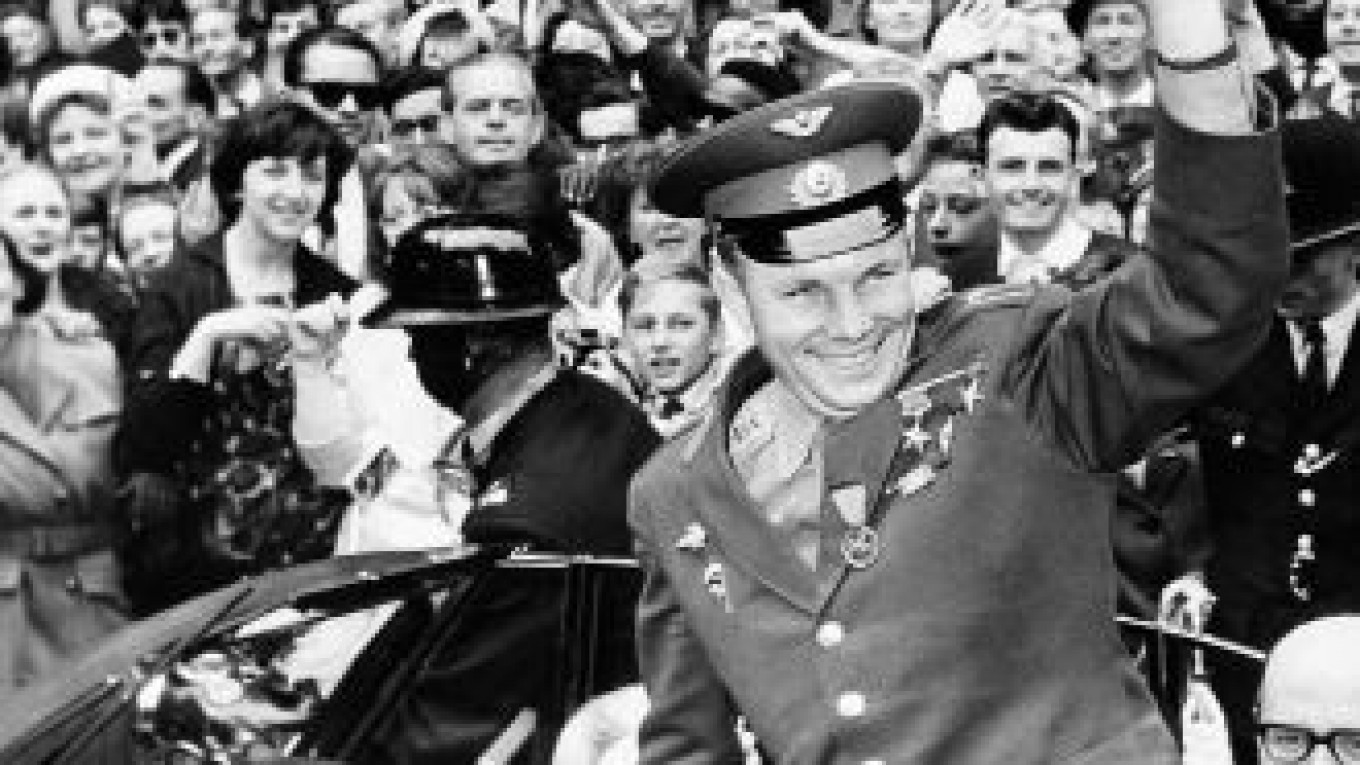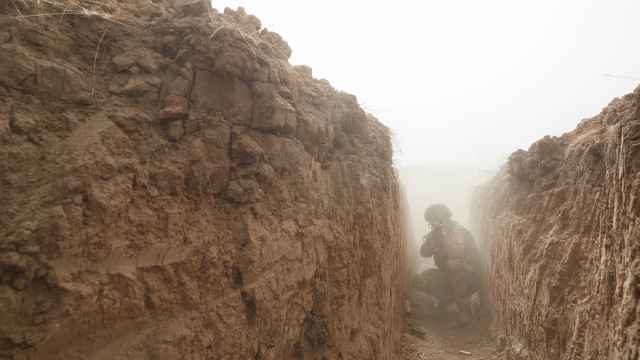STAR CITY, Moscow Region — It was the Soviet Union's own giant leap for mankind, one that would spur a humiliated United States to race for the moon. It happened 50 years ago on Tuesday, when an Air Force pilot named Yury Gagarin became the first human in space.
The 27-year-old cosmonaut's mission lasted just 108 minutes and was fraught with drama: a break in data transmission, glitches involving antennas, a retrorocket and the separation of modules. And there was an overarching question that science had yet to answer: What would weightlessness do to a human being?
"There were all kinds of wild fears that a man could lose his mind in zero gravity, lose his ability to make rational decisions," recalled Oleg Ivanovsky, who oversaw the construction and launch of the Vostok spacecraft that carried Gagarin.
The flight was to be fully automatic, but what if weightlessness caused Gagarin to go mad and override the programmed controls? The engineers' solution was to add a three-digit security code that the cosmonaut would have to enter to gain command of the spacecraft.
It proved unnecessary. The flight went off safely, and the handsome Russian with the big smile became a poster boy for the communist world, still a national idol 43 years after his death in a jet training accident and remembered with enormous affection by the last surviving pioneers of the Soviet space program at Star City outside Moscow, where he trained.
From the stern and uncompromising chief designer, Sergei Korolyov, to young nurses and rank-and-file launch pad workers, "people loved, really loved him," Ivanovsky said in a telephone interview.
Korolyov was eager to cement the Soviet edge in space after the October 1957 launch of Sputnik, the world's first manmade satellite, and he wanted to move to human spaceflight and score another victory in the race against the Americans.
But after a series of botched experimental flights throughout 1960 and a launch pad explosion that killed 126 people, safety was an overriding priority, Ivanovsky said.
The flight was limited to a single orbit because of the questions about weightlessness, and Gagarin was supposed to parachute out of the capsule on return because a soft-landing system was not ready yet.
Even so, Ivanovsky said, the risk was assessed as high. A top design official at the time, Boris Chertok, wrote in his memoirs that "Judging by modern standards of rockets reliability, we had no reasons for optimism by April 1961."
However, James Oberg, a NASA veteran and currently a space consultant who has studied the Soviet space program extensively, said Korolyov and his men did all they could to make the flight safe.
"I don't see any dangerous shortcuts in their approach to the Vostok," he said, adding that the two final launches before Gagarin's flight were fully successful.
Despite the risks, competition for the mission was strong among the 20 young pilots on the shortlist, and Gagarin was the favorite. He was a man who made people feel at ease and radiated kindness, former cosmonaut Vladimir Shatalov, now 83, recalled at the Star City training center, which he headed for 20 years.
Just three days before blastoff from what would later be known as the Baikonur Cosmodrome in Kazakhstan, Gagarin was told that he was chosen for the mission. In a letter to his wife, Valentina, he asked her to raise their daughters "not as little princesses, but as real people," and to feel free to remarry if his mission proved fatal.
"My letter seems like a final will. But I don't think so and I hope you will never see this letter and I will feel shame later for that brief moment of weakness," he wrote.
"Gagarin was aware of the fears concerning zero gravity, and he also knew about all failed launches preceding his flight," but he never showed any fear or doubt, Ivanovsky said.
On the eve of the flight, Gagarin and his backup, German Titov, went to bed early and were awakened at 5:30 a.m. Gagarin was joking, his pulse was an exemplary 64 beats a minute, and it remained the same after he took his seat in the Vostok.
Before boarding, Gagarin saw Korolyov looking haggard after a sleepless night. "Don't you worry, Sergei Pavlovich," he told the chief designer, "everything will be just fine."
"It was he who was comforting me!" Korolyov would marvel later. He thought of Gagarin as a son, and Gagarin carried Korolyov's picture in his wallet.
The security code for use in emergency was supposed to stay in a sealed envelope for the cosmonaut to open only if necessary, but Ivanovsky was too nervous to stick with protocol. As he escorted Gagarin to the capsule, he whispered the code to him: 1-2-5. Gagarin smiled and said he already knew; his instructor, equally protective, had already let him in on the secret.
Ivanovsky helped Gagarin up the ladder and into the cockpit, patted him on the helmet and wished him luck before closing the hatch, only to hear Korolyov telling him from the control room that a light that was meant to indicate the hatch was hermetically closed had failed to turn on. Ivanovsky and his two assistants had to remove all 32 screws sealing the hatch and then put them back at a frantic pace.
Inside the capsule, Gagarin was whistling a tune. Later he would joke to Ivanovsky: "You should have seen yourself while you were working on the hatch; your face had all the colors of tarnished metal."
Gagarin's rocket lifted off as scheduled on April 12, 1961, at 9:07 a.m. Moscow time. "Poyekhali!" (Let's go!), the cosmonaut shouted as he took off.
Korolyov and his engineers quickly got their first jolt: a signal suggesting a problem with the booster. It turned out to be just a break of a few seconds in data transmission. Gagarin's confident reports from orbit eased the tension, and only after the flight it emerged that an antenna malfunction had put the Vostok into a much higher and riskier orbit.
On re-entry, a glitch involving a retrorocket made the ship rotate swiftly, and the landing capsule was slow to jettison the service module. Scientists had to take a deep breath as they lost contact with the ship during its fiery earthward plunge.
Gagarin bailed out as planned and parachuted onto a field near the Volga River about 720 kilometers southeast of Moscow. There he was spotted by a forester's wife and her granddaughter who tried to run away from the stranger in his bright orange space suit and white helmet. They may have thought he was a U.S. spy, given that less than a year before, U.S. pilot Francis Gary Powers had been shot down over the Soviet Union in his U-2 spy plane, an incident that had badly strained U.S.-Soviet relations.
"Hey, where are you running? I'm one of us!" Gagarin shouted. Then others arrived, realizing he was the cosmonaut they had just heard about on the radio.
Gagarin learned to his great surprise that while aloft, he was being promoted two levels higher, to major. Korolyov and others flew to the landing area and met with Gagarin at a Communist Party guesthouse. Their raucous reunion lasted late into the night. On April 14 Gagarin was flown to Moscow, where he was greeted by Soviet leader Nikita Khrushchev and driven into town on a highway lined with cheering Russians.
"People took to the streets; everybody felt excited, it felt like V-Day," Korolyov's daughter Natalya recalled.
But amid the triumph, Soviet officials, ever obsessed with secrecy and image, already were airbrushing history.
Some local papers quoted witnesses who saw Gagarin parachuting down. But the official version had him landing in his capsule, so the KGB rushed to confiscate all the contradictory accounts in print. Soviet officials also lied about the launch pad's location, a foolish attempt to conceal what the West already knew.
Lies about the flight later caused friction with FAI, the international federation certifying aerospace records whose rules require that a pilot land in his craft.
Americans, waking up as the Soviet Union was well into its celebrations, were shocked. The next day members of Congress grilled NASA officials. One demanded that the United States be put on a war footing.
NASA explained that the Soviets had a greater lead-time, having started their effort in 1954, four years before the U.S. space agency was founded.
Twenty-three days after Gagarin's flight, on May 5, 1961, American Alan Shepard became the second man in space. But his suborbital hop lasted just 15 minutes. It wasn't until John Glenn's flight on Feb. 20, 1962, that an American managed to emulate Gagarin's globe-circling feat.
"Now let the other countries try to catch us," Gagarin had declared after returning from space, and the United States quickly set out to do so. Barely three weeks after Shepard's launch, President John F. Kennedy committed the nation to putting a man on the moon by decade's end. The goal was achieved in July 20, 1969.
Gagarin's legacy, meanwhile, has been dogged by conspiracy theories. Rumors still abound of botched and fatal space missions, the result of pervasive secrecy that surrounded the Soviet space program. "The degree of secrecy created shadows in which monsters could lurk," said Oberg, the NASA veteran.
Some early flights used mannequins that might have been mistaken for real people. But at least one death was real: Cosmonaut Valentin Bondarenko died in a pressure chamber fire during ground training less than a month before Gagarin's flight. His death became known only after Mikhail Gorbachev launched his reforms in the 1980s.
And then there was Gagarin's own death on March 27, 1968. It still drives conspiracy theories that the KGB wanted him dead because he supposedly opposed the Soviet regime.
Shatalov, the former cosmonaut, sat in his own jet, waiting his turn to take off after Gagarin and his crewman. He saw his friend smile and wave, and the next thing he knew, their MiG-15 had crashed into a forest. Shatalov surmises that the shock wave from another plane's sonic boom was to blame.
Maybe he should have stopped flying after his leap into space, Shatalov said. "But he really loved it and fought hard to keep doing it."
After Gagarin's death, the letter he had written to his wife on the eve of his space mission was finally given to her.
Valentina Gagarina has never remarried. She published a memoir but has stayed out of the public eye, living a secluded life at Star City. Daughter Yelena is the chief keeper of the Kremlin museums. Younger daughter Galina teaches economics at a Moscow university.
Gagarin's flight on the Vostok was entirely automated, yet simply by having the courage to face the unknown, he taught his fellow humans a vital lesson: that they had a future in space.
"Before this first flight there were reasonable suspicions that human beings weren't made for this environment," Oberg said. "And once Gagarin answered that question, I think every other discovery on every other manned spaceflight was just details. He answered the most challenging, the most awesome question by his performance."
A Message from The Moscow Times:
Dear readers,
We are facing unprecedented challenges. Russia's Prosecutor General's Office has designated The Moscow Times as an "undesirable" organization, criminalizing our work and putting our staff at risk of prosecution. This follows our earlier unjust labeling as a "foreign agent."
These actions are direct attempts to silence independent journalism in Russia. The authorities claim our work "discredits the decisions of the Russian leadership." We see things differently: we strive to provide accurate, unbiased reporting on Russia.
We, the journalists of The Moscow Times, refuse to be silenced. But to continue our work, we need your help.
Your support, no matter how small, makes a world of difference. If you can, please support us monthly starting from just $2. It's quick to set up, and every contribution makes a significant impact.
By supporting The Moscow Times, you're defending open, independent journalism in the face of repression. Thank you for standing with us.
Remind me later.






